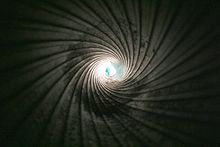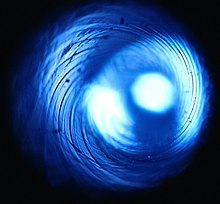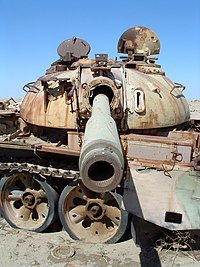Rifling: Difference between revisions
Rearranging and partial rewrite, adding references |
|||
| Line 10: | Line 10: | ||
==Construction and operation== |
==Construction and operation== |
||
[[Image:Polygonal vs normal rifling.svg|thumb|right|Conventional rifling (left) and polygonal rifling (right).]] |
[[Image:Polygonal vs normal rifling.svg|thumb|right|Conventional rifling (left) and [[polygonal rifling]] (right).]] |
||
A barrel of circular cross-section is not capable of imparting a spin to a projectile, so a rifled barrel has a non-circular cross-section. Typically the rifled barrel contains one or more grooves that run down its length, giving it a cross-section resembling a [[gear]], though it can also take the shape of a [[polygon]], usually with rounded corners. Since the barrel is not circular in cross-section, it cannot be accurately described with a single diameter. Rifled bores may be described by the ''bore diameter'', which is the diameter across the lands, or high points in the rifling, or by ''groove diameter'', which is the diameter across the grooves, or the low points in the rifling. Differences in naming conventions for [[cartridge (firearms) | cartridges]] can cause confusion; the [[.303 British]] is actually slightly larger in diameterthan the [[.308 Winchester]], because the ".303" refers to the bore diameter in inches, while the ".308" refers to the groove diameter in inches (7.70 mm and 7.82 mm). |
A barrel of circular cross-section is not capable of imparting a spin to a projectile, so a rifled barrel has a non-circular cross-section. Typically the rifled barrel contains one or more grooves that run down its length, giving it a cross-section resembling a [[gear]], though it can also take the shape of a [[polygonal rifling|polygon]], usually with rounded corners. Since the barrel is not circular in cross-section, it cannot be accurately described with a single diameter. Rifled bores may be described by the ''bore diameter'', which is the diameter across the lands, or high points in the rifling, or by ''groove diameter'', which is the diameter across the grooves, or the low points in the rifling. Differences in naming conventions for [[cartridge (firearms) | cartridges]] can cause confusion; the [[.303 British]] is actually slightly larger in diameterthan the [[.308 Winchester]], because the ".303" refers to the bore diameter in inches, while the ".308" refers to the groove diameter in inches (7.70 mm and 7.82 mm). |
||
Despite differences in form, the common goal of rifling is to deliver the projectile accurately to the target. In addition to imparting the spin to the bullet, the barrel must hold the projectile securely and concentrically as it travels down the barrel. This requires that the rifling meet a number of tasks:<ref name=lilja_accurate /> |
Despite differences in form, the common goal of rifling is to deliver the projectile accurately to the target. In addition to imparting the spin to the bullet, the barrel must hold the projectile securely and concentrically as it travels down the barrel. This requires that the rifling meet a number of tasks:<ref name=lilja_accurate /> |
||
Revision as of 00:58, 20 August 2008


Rifling refers to helix-shaped pattern in the barrel of a firearm, by which the firearm imparts a spin to a projectile around its long axis. This spin serves to gyroscopically stabilize the projectile, improving its stability and accuracy.
Rifling is described by a twist rate, which indicates what distance the bullet must travel to complete one full revolution, such as turn in 10 inches, or 1 turn in 30 cm. A shorter distance indicates a faster twist, meaning that for a given velocity the projectile will be rotating at a higher rate of spin.
The shape of a projectile determines the twist rate needed to stabilize it; short, barrels intended for short, large diameter projectiles like spherical balls require a very low twist rate, such as 1 turn in 48 inches (122 cm).[1] Barrels intended for long, small diameter bullets, such as the ultra low drag, 80 grain 0.224 inch bullets (5.2 g, 5.56 mm), use twist rates of 1 turn in 8 inches (20 cm) or faster.[2]
In some cases, rifling will have twist rate that increases down the length of the barrel, called a gain twist; a twist rate that decreases from breech to muzzle is undesirable, as it cannot reliably stabilize the bullet as it travels down the bore.[3][4] Extremely long projectiles may require impractically high twist rates; these projectiles must be inherently stable, and are often fired from a smoothbore barrel. See flechette for more information.
Construction and operation

A barrel of circular cross-section is not capable of imparting a spin to a projectile, so a rifled barrel has a non-circular cross-section. Typically the rifled barrel contains one or more grooves that run down its length, giving it a cross-section resembling a gear, though it can also take the shape of a polygon, usually with rounded corners. Since the barrel is not circular in cross-section, it cannot be accurately described with a single diameter. Rifled bores may be described by the bore diameter, which is the diameter across the lands, or high points in the rifling, or by groove diameter, which is the diameter across the grooves, or the low points in the rifling. Differences in naming conventions for cartridges can cause confusion; the .303 British is actually slightly larger in diameterthan the .308 Winchester, because the ".303" refers to the bore diameter in inches, while the ".308" refers to the groove diameter in inches (7.70 mm and 7.82 mm).
Despite differences in form, the common goal of rifling is to deliver the projectile accurately to the target. In addition to imparting the spin to the bullet, the barrel must hold the projectile securely and concentrically as it travels down the barrel. This requires that the rifling meet a number of tasks:[4]
- It must be sized so that the projectile will swage or obturate upon firing to fill the bore.
- The diameter should be consistent, and must not increase towards the muzzle.
- The rifling should be consistent down the length of the bore, without changes in cross-section, such as variations in groove width or spacing.
- It should be smooth, with no scratches lying perpendicular to the bore, so it does not abrade material from the projectile.
- The chamber and crown must smoothly transition the projectile into and out of the rifling.
When the projectile is swaged into the rifling, it takes on a mirror image of the rifing, as the lands push into the projectile in a process called engraving. Engraving takes on not only the major features of the bore, such as the lands and grooves, but also minor features, like scratches and tool marks. The relationship between the bore characteristics and the engraving on the projectile are often used in [[forensic ballistics].
Fitting the projectile to the bore
The original firearms were loaded from the muzzle by forcing a ball from the muzzle to the breech. Whether using a rifled or smooth bore, a good fit was needed to seal the bore and provide the best possible accuracy from the gun. To ease the force required to load the projectile, these early guns used an undersized ball, and a patch made of cloth, paper, or leather to fill the windage, the gap between the ball and the walls of the bore. The patch provided some degree of sealing, kept the ball seated on the charge of black powder, and kept the ball concentric to the bore. In rifled barrels, the patch also provided a means to transfer the spin from the rifling to the bullet, as the patch is "engraved" rather than the ball. Until the advent of the hollow based Minié ball, which obturates upon firing to seal the bore and engage the rifling, the patch provided the best means of getting the projectile to engage the rifling.[5]
In cartridge firearms, the need to force the projectile down the bore by hand is absent. With cartridge firearms, the task of seating the projectile into the rifling is handed by a part of the chamber called the throat. Next is the freebore, which is the length of throat down which the projectile travels before the rifling starts. The last section of the throat is the throat angle, where the throat transitions into the rifled barrel.
The throat is usually sized slightly larger than the projectile, so the loaded cartridge can be inserted and removed easily, but the throat should be as close as practical to the groove diameter of the barrel. Upon firing, the projectile expands under the pressure from the chamber, and obturates to fit the throat. The bullet then travels down the throat and engages the rifling, where it is engraved, and begins to spin. Engraving the projectile requires a significant amount of force, and in some firearms there is a significant amount of freebore, which helps keep chamber pressures low by allowing the propellant gases to expand before being required to engrave the projectile. Best accuracy, however, is typically provided with a minimum of freebore, maximizing the changes that the projectile will enter the rifling without distortion.[6][7]
History
The history of rifling a barrel is covered in depth in the article Rifle.
Manufacture


Most rifling is created by either:
- cutting one groove at a time with a machine tool, called cut rifling or single point cut rifling
- cutting all grooves in one pass with a special progressive broaching bit, called broached rifling
- pressing all grooves at once with a tool called a "button" that is pushed or pulled down the barrel, called button rifling
- forging the barrel over a mandrel containing a reverse image of the rifling (and often the chamber as well), called hammer forged
- flow forming the barrel preform over a mandrel containing a reverse image of the rifling, called rifling by flow forming. A new developed method by MACDOR company of Turkey.
The grooves are the spaces that are cut out, and the resulting ridges are called "lands". These lands and grooves can vary in number, depth, shape, direction of twist ("right" or "left"), and "twist rate" (turns per unit of barrel length). The spin imparted by rifling significantly improves the stability of the projectile, improving both range and accuracy. Typically rifling is a constant rate down the barrel, usually measured by the length of travel required to produce a single turn. Occasionally firearms are encountered with a gain twist, where the rate of spin increases from chamber to muzzle. While intentional gain twists are rare, due to manufacturing variance, a slight gain twist is in fact fairly common. Since a reduction in twist rate is very detrimental to accuracy, gunsmiths who are machining a new barrel from a rifled blank will often measure the twist carefully so they may put the faster rate, no matter how minute the difference is, at the muzzle end (see internal ballistics for more information on accuracy and bore characteristics).
Twist rate
For best performance, the barrel should have a twist rate sufficient to stabilize any bullet that it would reasonably be expected to fire, but not significantly more. Large diameter bullets provide more stability, as the larger radius provides more gyroscopic inertia, while long bullets are harder to stabilize, as they tend to be very backheavy and the aerodynamic pressures have a longer "lever" to act on. The slowest twist rates are found in muzzleloading firearms meant to fire a round ball; these will have twist rates as low as 1 in 60 inches (1,500 mm), or slightly longer, although for a typical multi-purpose muzzleloader rifle, a twist rate of 1 in 48 inches (1,200 mm) is very common. The M16A2 rifle, which is designed to fire the SS109 bullet, has a 1 in 7-inch (180 mm) twist. Civilian AR-15 rifles are commonly found with 1 in 12 inches (300 mm) for older rifles and 1 in 9 inches (230 mm) for most newer rifles, although some are made with 1 in 7 inches (180 mm) twist rates, the same as used for the M16. Rifles, which generally fire longer, smaller diameter bullets, will in general have higher twist rates than handguns, which fire shorter, larger diameter bullets.
George Greenhill, a mathematician at Emmanuel College, Cambridge, UK, developed a rule of thumb for use in calculating twist rates for a given lead-core bullet. The formula, named the Greenhill Formula in his honour, is:
where:
- C = 150 (use 180 for muzzle velocities higher than 2,800 f/s)
- D = bullet's diameter in inches
- L = bullet's length in inches
- SG = bullet's specific gravity (10.9 for lead-core bullets, which cancels out the second half of the equation)
The original value of C was 150, which yields a twist rate in inches per turn, when given the diameter D and the length L of the bullet in inches. This works to velocities of about 840 m/s (2800 ft/s); above those velocities, a C of 180 should be used. For instance, with a velocity of 600 m/s (2000 ft/s), a diameter of 0.5 inches (13 mm) and a length of 1.5 inches (38 mm), the Greenhill formula would give a value of 30, which means 1 turn in 30 inches (760 mm).

If an insufficient twist rate is used, the bullet will begin to yaw and then tumble; this is usually seen as "keyholing", where bullets leave elongated holes in the target as they strike at an angle. Once the bullet starts to yaw, any hope of accuracy is lost, as the bullet will begin to veer off in random directions as it precesses.
Conversely, too-high a rate of twist can also cause problems. The excessive twist can cause accelerated barrel wear, and in high velocity bullets, an excessive twist can cause a very high spin rate in excess of the bullet's burst speed (see centripetal force). A higher twist than needed can also cause more subtle problems with accuracy: Any inconsistency in the bullet, such as a void that causes an unequal distribution of mass, may be magnified by the spin. Undersized bullets also have problems, as they may not enter the rifling exactly concentric and coaxial to the bore, and excess twist will exacerbate the accuracy problems this causes. Lastly, excessive spinning causes a reduction in the lateral kinetic energy of a projectile, thereby reducing its destructive power (the energy instead becomes rotational kinetic energy).
Recent developments
The grooves most commonly used in modern rifling have fairly sharp edges. More recently, polygonal rifling, a throwback to the earliest types of rifling, has become popular, especially in handguns. Polygonal barrels tend to have longer service lives because the reduction of the sharp edges of the land reduces erosion of the barrel. Supporters of polygonal rifling also claim higher velocities and greater accuracy. Polygonal rifling is currently seen on pistols from Heckler & Koch, Glock and Kahr Arms, as well as the Desert Eagle.
For tanks and artillery pieces, the extended range, full bore concept developed by Gerald Bull for the GC-45 howitzer reverses the normal rifling idea by using a shell with small fins that ride in the grooves, as opposed to using a slightly oversized projectile which is forced into the grooves. Such guns have achieved significant increases in muzzle velocity and range. Examples include the South African G5 and the German PzH 2000.
See also
References
- ^ Randy D. Smith. "The .54 Caliber Muzzleloader".
{{cite web}}: Unknown parameter|puiblisher=ignored (|publisher=suggested) (help) - ^ "Products::Rifle Barrels::Calibers and Twists". Shilen Rifles, Inc.
- ^ "gain twist". MidwayUSA GunTec Dictionary.
- ^ a b Dan Lilja. "What makes a barrel accurate?".
- ^ Sam Fadala (2006). The Complete Blackpowder Handbook: The Latest Guns and Gear. Gun Digest. ISBN 0896893901. Chapter 18, The Cloth Patch
- ^ cite book |title=Handbook for Shooters & Reloaders Volume II |author=P. O. Ackley |publisher=Plaza Publishing |year=1966}} pages 97-98
- ^ Daniel Lilja. "Thoughts on Throats for the 50 BMG".
External links
- Article on barrel making from an IHMSA shooter
- Rifling By Flow Forming A new developed method for rifling.
- Article on barrel making from Lilja, a maker of world class competition barrels
- Article on making and measuring rifling by Lilja; includes pictures of button rifling machine
- 6mmBR article on barrels
- Bore slugging tutorial, explaining now to determine the true bore and groove size and choose appropriate bullet diameters

